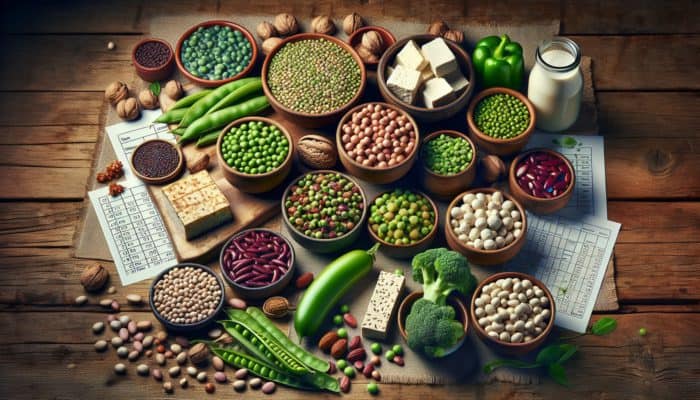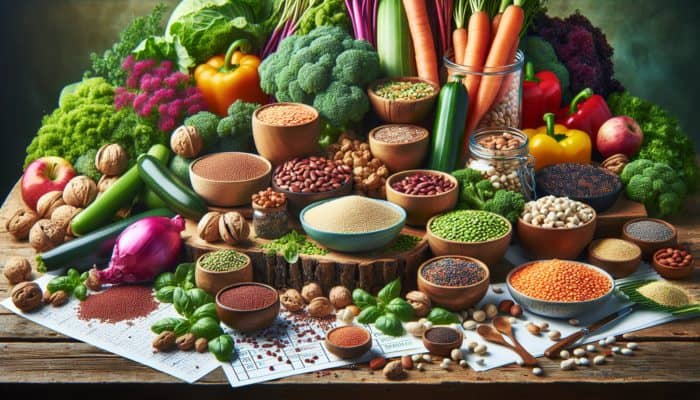Maximize Your Health with Plant-Based Protein Stacking Techniques
What Is Plant-Based Protein Stacking and Why Is It Important?

Stacking Plant-Based Proteins Effectively: Plant-based protein stacking is the strategic method of combining various plant protein sources to create a comprehensive profile of essential amino acids that our bodies need for peak performance and health. This technique not only amplifies nutrient absorption but also enhances the overall quality of a plant-based diet. The primary sources of plant proteins you should consider incorporating are:
- Legumes (e.g., lentils, chickpeas, black beans)
- Grains (e.g., quinoa, brown rice, oats)
- Nuts and seeds (e.g., almonds, chia seeds, hemp seeds)
- Tofu and tempeh
- Seitan (wheat gluten)
- Peas and pea protein
- Green vegetables (e.g., spinach, broccoli)
- Spirulina and other algae
The harmonious blending of these plant proteins is crucial for establishing a comprehensive amino acid profile, which is essential for meeting diverse nutritional requirements and individual preferences.
What Are the Health Benefits of Using Diverse Protein Sources?
Engaging with a wide array of protein sources offers myriad health benefits that contribute to overall well-being. By incorporating a variety of plant proteins, you enrich your daily diet with an extensive range of nutrients, vitamins, and minerals. The advantages include:
- Enhanced muscle recovery and growth
- Improved digestion and gut health
- Balanced blood sugar levels
- Increased energy levels throughout the day
- Boosted immune function
- Support for heart health
- Reduction in inflammation
- Promotion of sustainable eating habits
By diversifying their protein intake, individuals can better align their diets with personal health objectives, whether those are related to fitness, weight management, or overall wellness goals.
How Can You Start Stacking Proteins Successfully?
Starting your journey toward effective protein stacking begins with an in-depth understanding of your unique dietary needs and preferences. Evaluating your specific protein requirements is crucial, as these can vary based on factors such as age, activity level, and personal health goals. By making a thoughtful selection of complementary plant proteins, you can create a balanced diet tailored to your individual needs.
Begin by identifying which plant proteins resonate most with your lifestyle. For instance, if you lead a busy professional life, consider convenient options like protein-packed smoothies featuring pea protein and hemp protein, or quick meals that include quinoa and black beans. By integrating these combinations into your daily routine, you can ensure a continuous supply of amino acids that enhance your nutrient absorption and utilization.
Expert Tips for Effectively Stacking Plant-Based Proteins

What Are the Best Practices for Successful Protein Stacking?
To effectively stack proteins, it's vital to have a thorough grasp of the amino acid profiles of various plant proteins. Not all plant proteins provide all essential amino acids in adequate amounts, making strategic combinations necessary. For example, legumes are often deficient in methionine but rich in lysine, while grains typically have the opposite amino acid profile.
Real-world examples of successful protein stacking can be observed in vegetarian and vegan athletes who frequently combine different protein sources to enhance their performance. For instance, a post-exercise smoothie made from banana, almond milk, and a scoop of pea protein can deliver a robust amino acid profile, facilitating muscle recovery while also providing essential nutrients.
Consider incorporating snacks like hummus paired with whole-grain pita or almond butter spread on whole-grain toast to intake complementary proteins throughout your day consistently. This method not only helps you achieve a balanced diet but also maintains steady energy levels and supports faster recovery.
How Can You Maximize Protein Absorption?
To optimize protein absorption, it is crucial for individuals looking to reap the full benefits of their plant protein consumption. Employ several actionable strategies to achieve this. First, ensure you are consuming an adequate amount of protein at every meal, as evenly distributing your intake can promote better absorption. Additionally, pairing your plant-based proteins with other nutrients, such as healthy fats and carbohydrates, can enhance digestion, allowing your body to utilize proteins more effectively.
For example, consuming a meal that includes lentils (rich in protein) alongside avocado (which provides healthy fats) can facilitate improved nutrient absorption. Furthermore, practicing mindful eating—taking time to chew thoroughly and savor each bite—can also contribute to better digestion and absorption rates. It's also wise to consider the timing of your protein intake; consuming protein-rich foods immediately after exercise can help maximize muscle repair and growth.
What Role Does Timing Play in Your Protein Stacking Strategy?

Timing plays a crucial role in determining how effectively your body can utilize the proteins you consume. Strategically spacing your protein intake can enhance muscle recovery and nutrient distribution throughout the day. For instance, consuming a protein-rich breakfast that includes a blend of chia seeds, oatmeal, and almond milk sets a strong foundation for the day, ensuring your body has the necessary building blocks for muscle repair and sustained energy throughout the day.
Moreover, aiming to space out protein intake every 3-4 hours can maximize protein synthesis, particularly for individuals involved in regular physical activity. By timing your meals and snacks strategically, you can fully optimize the benefits of protein stacking, which ultimately leads to enhanced muscle recovery, decreased fatigue, and improved overall health.
How Does Protein Stacking Improve Nutritional Profiles?
What Are the Essential Amino Acids You Should Focus On?
Essential amino acids (EAAs) are the fundamental building blocks of proteins that our bodies cannot synthesize independently, making them crucial for various bodily functions. In the context of protein stacking, it's vital to understand which plant sources deliver these EAAs to enhance your dietary planning significantly. The nine essential amino acids include histidine, isoleucine, leucine, lysine, methionine, phenylalanine, threonine, tryptophan, and valine.
Plant-based sources, such as quinoa, soy, and chia seeds, are often considered complete proteins because they contain all nine essential amino acids. However, many other plant proteins, such as beans and grains, may lack one or more EAAs, making it essential to combine them effectively. For example, pairing rice (low in lysine) with beans (high in lysine) creates a complete protein source, ensuring that your body receives the necessary amino acids for optimal functioning.
Having a comprehensive understanding of which foods supply these essential amino acids empowers you to create a balanced diet that meets your nutritional requirements while reducing the risk of deficiencies.
How Can You Create a Complete Protein Profile?
Creating a complete protein profile through plant protein stacking is essential for individuals pursuing high-quality nutrition. The key lies in knowing which combinations of plant proteins can meet your amino acid needs. For instance, the classic pairing of rice and beans provides a complete protein profile, effectively balancing each other's amino acid deficiencies.
To achieve a comprehensive protein profile, aim to consume a variety of sources throughout the day. Incorporate foods such as lentils, chickpeas, quinoa, nuts, and seeds into your meals and snacks to boost your nutrition. For example, a salad topped with chickpeas, sunflower seeds, and a quinoa base not only provides a wide array of nutrients but also guarantees a strong amino acid profile.
Additionally, rotating your protein sources weekly can keep your diet exciting and varied. By combining different proteins, such as introducing tempeh into a stir-fry or adding nutritional yeast to sauces for a cheesy flavor, you can maintain flavorful meals while ensuring complete nutrition.
What Impact Does Protein Stacking Have on Your Health?
Protein stacking has a profound impact on overall health by promoting balanced nutrition and enhancing physical performance. Those who engage in effective protein stacking often experience improvements in muscle growth and recovery from physical exertion, which is particularly advantageous for athletes, fitness enthusiasts, and individuals with active lifestyles.
Incorporating a variety of plant-based proteins ensures that you're not only fulfilling your protein requirements but also gaining access to a broad spectrum of vitamins and minerals. For example, the antioxidants found in legumes and the healthy fats in nuts contribute to reduced inflammation and improved heart health.
Furthermore, maintaining a balanced protein intake can facilitate better weight management, as proteins are known to enhance feelings of fullness and decrease overall caloric consumption. By implementing protein stacking, you can transform your nutrition approach, leading to tangible health benefits and an improved quality of life.
How Does the Timing of Protein Intake Affect Stacking?
The timing of protein intake is essential when it comes to maximizing the benefits of protein stacking. Consuming protein-rich foods at optimal moments can align with your body's natural rhythms and metabolic processes, improving nutrient absorption and utilization. For instance, the post-workout window is typically regarded as the optimal time to consume protein, which significantly influences muscle recovery and growth.
To optimize results, aim to consume a balanced meal containing protein within 30 minutes to two hours after exercising. This could involve a blend of plant proteins, like a smoothie made with almond milk, banana, and a scoop of protein powder. This not only aids in muscle repair but also replenishes glycogen stores.
Additionally, ensuring you have protein-rich snacks available throughout your day, such as a handful of nuts or a protein bar made from plant sources, can help maintain steady energy levels and manage hunger. By understanding and respecting the timing of your protein intake, you can fully leverage the benefits of stacking, ultimately supporting your health and fitness goals.
What Role Do Plant-Based Proteins Play in Stacking?
Plant-based proteins are fundamental to the protein stacking process, providing a versatile and sustainable method to ensure adequate nutrient intake. Including these proteins in your diet not only supports your health goals but also promotes environmental sustainability. Generally, plant proteins are lower in saturated fat and higher in fiber compared to animal proteins, making them a healthier choice for the heart.
Incorporating a range of plant-based proteins can diversify your nutrient intake, delivering an abundance of vitamins, minerals, and phytonutrients essential for overall wellness. For instance, adding hemp seeds to smoothies or salads not only boosts protein content but also contributes omega-3 fatty acids, which support cardiovascular health.
Moreover, plant-based proteins cater to a variety of dietary preferences and restrictions. Whether someone identifies as vegan, vegetarian, or wishes to reduce meat consumption, plant proteins can easily fit into any dietary plan. By embracing the versatility of plant proteins, you can craft meals that are not only nutritious but also enjoyable, further promoting adherence to a balanced diet.
Research-Backed Evidence Supporting Effective Plant-Based Protein Stacking
What Scientific Studies Support Plant-Based Protein Stacking?
Numerous studies have highlighted the benefits of combining plant proteins to achieve a complete nutrition. Research suggests that consuming a diverse range of plant proteins can lead to enhanced muscle synthesis and improved health outcomes. For instance, studies have shown that individuals who incorporate a variety of protein sources experience enhanced overall health markers, including lower cholesterol levels and improved blood sugar regulation.
Additionally, comprehensive analyses have demonstrated that plant-based diets rich in protein stacking are associated with decreased risks of chronic conditions, including heart disease and type 2 diabetes. This body of research reinforces the idea that a diet focused on plant proteins can yield substantial health benefits, encouraging individuals to adopt protein stacking as a strategy for achieving optimal health.
Expert evaluations of impactful research underscore the importance of understanding protein dynamics. The combination of complementary proteins can enhance amino acid bioavailability, ensuring that the body efficiently receives essential nutrients. With this knowledge, individuals can adopt a more informed approach to their dietary choices, ultimately leading to improved health outcomes.
How Does Protein Stacking Influence Athletic Performance?
Protein stacking can significantly enhance athletic performance by providing sustained energy and facilitating muscle repair. Athletes frequently depend on a diverse assortment of plant proteins to optimize their performance results. For instance, the combination of lentils and quinoa offers a complete protein profile, making it an excellent post-workout meal to support muscle recovery and replenish energy stores.
Real-life examples of athletes who benefit from protein stacking are abundant. For instance, professional vegan athletes have successfully leveraged plant protein stacking to improve their recovery times and enhance performance metrics. By incorporating a well-balanced mix of proteins, these athletes can maintain their strength and endurance while promoting their overall health.
Moreover, studies indicate that individuals who practice plant protein stacking experience reduced muscle soreness and improved exercise performance. This is largely attributed to the optimized recovery process facilitated by the complete amino acid profiles achieved through thoughtful combinations of plant proteins.
Can Protein Stacking Enhance Overall Health?
Yes, protein stacking can significantly elevate overall health by ensuring a balanced intake of vital nutrients. By strategically combining plant proteins, individuals can access a broad spectrum of vitamins, minerals, and amino acids essential for optimal bodily function. For example, incorporating foods like beans, lentils, and whole grains can help stabilize blood sugar levels, support heart health, and enhance digestive health.
To seamlessly incorporate protein stacking into everyday meals, consider practical strategies such as meal prepping protein-rich dishes in advance or ensuring protein is included in every meal and snack. For instance, a breakfast smoothie featuring spinach, banana, and a scoop of pea protein can set a healthy tone for your day, while a lunch salad loaded with chickpeas and quinoa can sustain your energy levels into the afternoon.
Additionally, adopting a protein stacking routine can help minimize the risk of nutrient deficiencies often linked to restrictive diets. By ensuring a comprehensive intake of plant proteins, individuals can maintain a thriving, balanced diet that encourages long-term health and wellness.
Effective Strategies for Successful Protein Stacking
How to Strategically Plan Your Daily Protein Intake
Planning your daily protein intake requires a thorough understanding of your protein needs and strategically scheduling meals to maintain a balanced intake throughout the day. Begin by determining your protein requirements based on factors such as age, activity level, and health goals.
When structuring your daily intake, consider these practical tips:
- Set a baseline: Aim for a specific protein target (e.g., 1.2 to 2.0 grams of protein per kilogram of body weight, depending on your level of physical activity).
- Incorporate protein into all meals: Ensure your breakfast, lunch, and dinner include a source of plant protein.
- Snack wisely: Opt for protein-rich snacks like nuts, seeds, or hummus with veggies.
- Meal prep: Prepare meals in advance that incorporate a variety of plant proteins for easy access throughout the week.
- Experiment with combinations: Discover new protein pairings that yield complete amino acid profiles.
- Stay consistent: Make tracking your protein intake a regular practice to ensure you meet your goals.
- Adjust as needed: Be flexible and adjust your intake according to your changing needs and activity levels.
By adopting a proactive approach to your protein planning, you can ensure that your body receives the right nutrients to support your health and fitness objectives.
What Are the Most Effective Combinations for Protein Stacking?
Certain combinations of plant proteins can create a complete amino acid profile, significantly boosting the effectiveness of your protein stacking efforts. Recognizing these combinations can greatly assist in achieving your nutritional goals. For example, pairing legumes with grains is a classic and effective strategy; the combination of beans and rice is both flavorful and nutritionally beneficial.
Other potent combinations include:
- Lentils with quinoa
- Hummus with whole-grain pita
- Peanut butter on whole-grain bread
- Tofu with brown rice
- Chickpeas in a salad with nuts and seeds
- Seitan with vegetable stir-fry and rice
- Spirulina added to smoothies for an extra protein boost
- Almonds with yogurt made from soy or almond milk
These pairings not only enhance the amino acid profile but also deliver a rich assortment of vitamins, minerals, and phytonutrients that contribute to overall health. By incorporating these combinations into your meals and snacks, you can ensure that your protein intake is both effective and enjoyable.
How to Tailor Protein Stacking to Different Lifestyles
Adjusting your protein stacking strategy to accommodate different lifestyles is crucial for meeting diverse nutritional needs. For busy professionals, striking a balance between convenience and adequate protein intake is essential. Meal prepping protein-rich snacks and quick meals can help maintain a balanced diet. For instance, preparing overnight oats with almond butter and chia seeds offers a quick protein source to kickstart the day.
Athletes may require higher protein levels to facilitate muscle repair and recovery. Incorporating various protein sources into meals—such as adding hemp protein to smoothies and including lentils in salads—can help meet their higher protein requirements. Additionally, adjusting meal timing to consume protein-rich foods after workouts can enhance recovery.
Conversely, individuals leading a more relaxed lifestyle may prioritize enjoyment and variety in their meals. This could involve exploring different cuisines that feature plant proteins, such as Mediterranean dishes with chickpeas or Asian stir-fries with tofu. By understanding your unique lifestyle and its demands, you can customize your protein stacking approach to ensure it aligns with your health goals.
How to Monitor and Adjust Your Protein Intake Over Time
Regularly monitoring and adjusting your protein intake is vital for maintaining optimal nutrition as your body's requirements change. Start by keeping a food journal to track your daily protein consumption, noting the sources and amounts consumed. This practice will help you identify patterns and gaps in your diet.
As you progress, regularly reassess your protein needs based on factors such as changes in activity level, age, or health goals. If you find yourself feeling fatigued or not recovering adequately from workouts, consider increasing your protein intake by adding more protein-rich snacks or meals.
Incorporate a variety of protein sources into your diet to maintain excitement while ensuring a complete amino acid profile. Experimenting with different recipes and combinations can make the journey enjoyable and sustainable. For example, trying new plant-based protein powders or discovering unique recipes can keep you engaged with your protein stacking routine.
By consistently monitoring and adjusting your diet, you can ensure that it remains aligned with your evolving nutritional needs, ultimately supporting optimal health and well-being.
What Are the Common Challenges of Plant-Based Protein Stacking?
How to Address Protein Deficiency Risks in Plant-Based Diets?
Protein deficiency can pose a significant challenge for individuals following a plant-based diet, but with thoughtful planning, this risk can be effectively managed. To overcome potential deficiencies, it is essential to understand the protein content of various plant sources and how to combine them strategically. Make it a priority to include a wide variety of protein-rich foods in your daily meals.
For example, incorporating legumes, grains, nuts, and seeds ensures a diverse protein intake. A well-balanced meal could consist of a quinoa salad blended with chickpeas and topped with a sprinkle of pumpkin seeds. This approach allows you to create a complete amino acid profile while minimizing the risk of deficiency.
Moreover, focusing on protein timing can significantly enhance overall intake. Regularly consuming protein-rich snacks throughout the day—such as a protein bar or a smoothie made with plant-based protein powder—can provide a steady flow of amino acids, supporting muscle repair and growth. Educating yourself about plant protein sources will empower you to make informed choices, ensuring you thrive on a plant-based diet without worrying about deficiencies.
What Are the Common Misconceptions Surrounding Protein Stacking?
Misconceptions about protein stacking can prevent individuals from effectively integrating this practice into their diets. One widespread myth is that plant-based proteins are inferior to animal sources in terms of their amino acid profiles. While it's true that many plant proteins may be lower in certain essential amino acids, combining various sources can easily counteract this limitation.
Another misconception is the belief that it's necessary to consume protein at every meal to achieve optimal results. In reality, as long as your overall daily intake is sufficient and diverse, your body can effectively utilize amino acids over time.
Additionally, some may think that protein stacking is only necessary for athletes or bodybuilders; however, anyone aiming for a balanced and healthy diet can benefit from this practice. Educating yourself on the science behind protein and understanding the advantages of diverse sources will empower you to make informed dietary decisions, dispelling myths and leading to improved health outcomes.
How to Manage Digestive Issues Related to Plant Proteins?
Digestive issues may arise from consuming plant proteins, particularly for those who are not accustomed to high-fiber foods or specific legumes. However, these challenges can be effectively managed through proper preparation and a combination of approaches. Soaking legumes before cooking can help reduce compounds that may cause bloating and gas, making them easier to digest.
Gradually introducing plant proteins into your diet can also help your digestive system adjust. Start with smaller servings and incrementally increase the amount as your body adapts. Additionally, combining different plant proteins can enhance digestibility; for instance, pairing lentils with rice can make them easier to digest.
Incorporating digestive aids, such as fermented foods like kimchi or sauerkraut, can further support gut health. These foods contain beneficial probiotics that help break down proteins, thereby improving overall digestion. By being mindful of how you prepare and consume plant proteins, you can enjoy all the benefits of protein stacking while minimizing discomfort.
Proven Strategies for Effectively Stacking Plant-Based Proteins
How to Source High-Quality Plant-Based Proteins?
Sourcing high-quality plant-based proteins is essential for successful protein stacking. When selecting protein sources, scrutinize labels for quality indicators such as organic certification, non-GMO status, and transparent ingredient lists. Whenever possible, opt for whole food sources, as these typically retain more nutrients than processed options.
For instance, when choosing protein powders, select those with minimal additives that focus on natural ingredients. Research brands known for their responsible sourcing practices and transparency in production. Reading customer reviews can also provide valuable insights into the product's effectiveness and taste.
Additionally, consider visiting local farmers' markets or participating in community-supported agriculture (CSA) programs to obtain fresh, high-quality plant proteins. This approach not only supports local agriculture but also ensures that you consume the freshest, most nutrient-dense options available.
By being discerning about your sources, you can bolster your protein stacking efforts with high-quality options that contribute to optimal health.
What Are the Long-Term Benefits of Adopting Protein Stacking?
The long-term benefits of protein stacking are substantial, resulting in sustained health and improved muscle function. Regularly incorporating a diverse range of plant proteins into your diet can help maintain a balanced nutrient profile over time, significantly reducing the risk of chronic diseases, including obesity, heart disease, and type 2 diabetes.
Moreover, protein stacking promotes improved muscle recovery and growth, which is particularly beneficial for individuals who engage in regular physical activity. Sustained energy levels and enhanced performance can be achieved as the body adjusts to a consistent intake of high-quality plant proteins.
Integrating protein stacking into your routine can also facilitate better weight management, as plant proteins are known to enhance feelings of fullness and can help curb cravings. Over time, individuals may find it easier to maintain a healthy weight and adhere to a balanced diet.
To reap these long-term benefits, it is crucial to commit to a protein stacking routine that is both enjoyable and sustainable. This may involve experimenting with various sources, recipes, and meal combinations to determine what works best for you.
How to Seamlessly Integrate Protein Stacking into Your Diet?
Integrating protein stacking into your diet can be a smooth and enjoyable process. Start by gradually incorporating a variety of plant-based proteins into your meals. For instance, consider adding legumes, grains, nuts, seeds, and vegetables to your recipes to create well-rounded dishes.
Real-world examples of successful integration strategies include meal prepping protein-rich lunches, such as quinoa bowls with roasted vegetables and chickpeas, which are easily portable for work or school. Preparing snacks like trail mix with almonds, sunflower seeds, and dried fruit ensures you have protein-rich options readily available throughout the day.
Incorporating protein stacking into social gatherings can also be a fun way to explore new flavors and combinations. Prepare dishes that highlight plant proteins, such as bean dips with whole-grain crackers or vegan chili, to share with friends and family.
By embracing the diversity of plant-based proteins and creatively integrating them into your meals, you can make protein stacking an effortless part of your dietary lifestyle, supporting both health and enjoyment.
Frequently Asked Questions
What is the concept of protein stacking?
Protein stacking refers to the practice of combining various plant protein sources to achieve a complete amino acid profile, thereby enhancing overall nutrition.
Why should you consider stacking plant-based proteins?
Stacking plant-based proteins ensures a balanced intake of essential amino acids, which supports muscle growth, recovery, and overall health.
What are the top sources of plant protein?
Leading plant protein sources include legumes, grains, nuts, seeds, tofu, tempeh, and spirulina, each offering unique nutritional advantages.
How can I enhance protein absorption?
Optimize protein absorption by consuming balanced meals that include protein, healthy fats, and carbohydrates, and by timing your meals to coincide with exercise.
What combinations work best for effective stacking?
Effective combinations for stacking include rice and beans, lentils and quinoa, and hummus with whole-grain pita, among many others.
How can I effectively monitor my protein intake?
Monitor your protein intake by maintaining a food journal, using tracking apps, or establishing daily protein goals tailored to your dietary needs.
Can protein stacking assist with weight management?
Yes, protein stacking can promote satiety and reduce cravings, making it easier to manage weight while ensuring balanced nutrition.
Are there any digestive issues associated with plant proteins?
Some individuals may experience digestive issues with plant proteins, but these can be mitigated through proper preparation and gradual dietary introduction.
How does timing influence protein stacking?
Timing can optimize protein utilization; consuming protein-rich meals after exercise and throughout the day can enhance recovery and muscle synthesis.
What are the long-term benefits of protein stacking?
The long-term benefits of protein stacking include improved muscle function, sustained energy levels, better weight management, and a reduced risk of chronic diseases.


You’ve touched on such an essential aspect of nutrition that often goes overlooked, especially in the realm of plant-based diets. The concept of protein stacking truly resonates with me, not only for its biochemical advantages but also for its culinary potential. As someone who has been gradually transitioning to a more plant-based lifestyle, I’ve found that the ability to combine different protein sources not only enhances nutrition but also adds variety and excitement to meals.
It’s fascinating to read about plant-based protein stacking and its significance in achieving a balanced diet. As someone who transitioned to a plant-based diet a few years ago, I can attest to both the challenges and rewards of ensuring adequate protein intake. The concept of strategically combining different plant protein sources really resonates with me. It’s a practice I’ve come to appreciate, especially when I realized just how diverse and delicious these combinations can be.